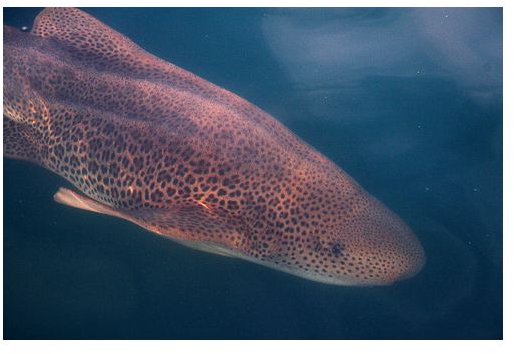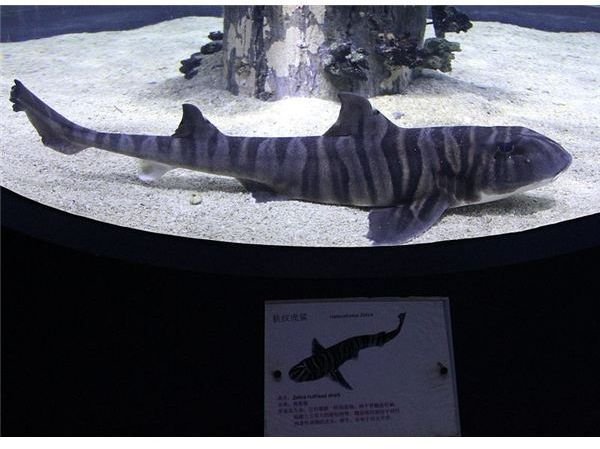Zebra Sharks Habitat; Where the Quick Change Artist of the Sea Lives
When Zebra sharks’ habitats were first discovered, taxonomists thought that young zebra sharks were a different species than the adults because of their vastly different markings. These sharks go through a complete skin marking change between early adolescence and adulthood.
There are three major stages: the zebra stripe stage, the mixed zebra leopard stage, and the final spotted leopard stage. The name for the juvenile shark (zebra shark) was adopted because leopard shark was already allocated to another species. This is how a spotted shark ends up with a striped name.
What Do They Look Like
Young Zebra Sharks
From the time it hatches until it reaches about 20 inches (1 foot 8 inches) in length, a young Zebra shark will have a dark brown to black body with light yellow to white underbelly and vertical stripes. This striping is where the shark initially got its name. The cylindrical body is topped with a body length caudal fin and ends in a tail almost as long as its body. As the young shark grows, it begins to lose the dark pigmentation on the majority of its skin.
Adolescent Sharks
When the young shark begins adolescence, it will be about 20 inches (1 foot 8 inches) long. The dark brown skin now begins to fade into a tan color leaving several dark spots over the majority of the body.
The vertical striping is still visible during this transitional period and lasts until the fish reaches about 35 inches in length. During this stage, five horizontal ridges begin to rise from the body of the shark. One runs along the top of the fish and attaches to the dorsal fin, while two others come up along each side.
Adult Leopard Sharks
When the Zebra shark has reached a length of 36 inches (3 feet) or more, all visible vertical striping has disappeared and the entire shark is a tan color with dark brown spots. The dorsal ridge, as well as the side ridges, has peaked and presents itself as a formidable defensive array. The shark’s body has flattened out a bit from its cylindrical shape but is still pliable and can squeeze into tight spaces that other sharks of its size can’t.
Where are They Found
Adult Zebra sharks are found in the intertidal zone of the Indian Ocean usually from 100 to 210 feet down. Adolescent sharks are often seen in shallower waters and the young have even been known to range up to a depth of 10 feet. These sharks spend an inordinate part of their lives in and around coral reefs. This may account for the development of the extremely long tail and large, broad pectoral fins. These fins can be used to pull themselves through tight areas in the reef while the strong tail helps to propel them through. This is one of the most interesting of the adaptations of the zebra bullhead shark.
The Zebra shark’s habitat is crucial to its sleeping and feeding habits. The close quarters of a reef allow the shark to prop itself up in a high current area so that high oxygen water flows over its gills while it sleeps. It sleeps during the daylight hours and hunts at night.
What Do They Eat
The night hunting done by the shark includes chasing through the reef for mollusks, crabs, shrimp and small fish. The body shape and powerful tail allow the normally docile shark to burst toward prey that try to escape. There is no difference in the feeding habits of young and adult sharks, but it is theorized by some marine biologists that the colorings on the younger sharks act as a sort of uniform that announces to larger sharks that they are not a threat to take over feeding grounds. This territorial based theory is widely accepted, but there may be a second, more intriguing reason for the pattern change.
Predators

Zebra sharks have few predators in the open ocean but those it does have are formidable. Larger sharks will prey on the young zebra sharks and this leads to the second theory for the striping on the young sharks. Just like their namesakes in the savannah, the stripes on young sharks may act as a collective camouflage. If the young stay together, the stripes may coordinate to make them look like one large animal instead of several small ones and thus deter a potential predator.
The most dangerous predator to one of these docile creatures is man. Shark fin soup and fresh shark meat are delicacies around several parts of the zebra shark’s habitat.
Commercial fishing of these fish has driven them to the vulnerable list according to the World Conservation Union. Some protective measures have been put into place but the major commercial fishing of zebra sharks still goes on. Without a more serious effort to stop the over fishing of these sharks, these unique creatures will soon be relegated to the annals of history.
References
“Coral Reefs: Zebra Shark.” ReefQuest Centre for Shark Research Home. Web. 21 July 2011. https://www.elasmo-research.org/education/ecology/coral-zebra.htm
“FLMNH Ichthyology Department: Zebra Shark.” Florida Museum of Natural History. Web. 21 July 2011. https://www.flmnh.ufl.edu/fish/Gallery/Descript/ZebraShark/ZebraShark.html
“Shedd Aquarium - Chicago | Zebra Sharks.” Shedd Aquarium - Chicago | Home. Web. 21 July 2011. https://www.sheddaquarium.org/zebrasharks.html
“Zebra Shark, Coral Reefs, Fishes, Stegostoma Varium.” Monterey Bay Aquarium. Web. 21 July 2011. https://www.montereybayaquarium.org/animals/AnimalDetails.aspx?legacyid=514
“Zebra Shark, Stegostoma Fasciatum at MarineBio.org.” MarineBio.org - Marine Biology, Ocean Life Conservation, Sea Creatures, Biodiversity, Oceans Research… Web. 21 July 2011. https://marinebio.org/species.asp?id=56
Image of “Adult Zebra Shark” courtesy of Kyle T. Ramirez @ FlickR, https://www.flickr.com/photos/kyletramirez/3476768359/sizes/m/in/photostream/
Image of Juvenile Zebra Shark by Jason Quinn under CC BY-SA 3.0
